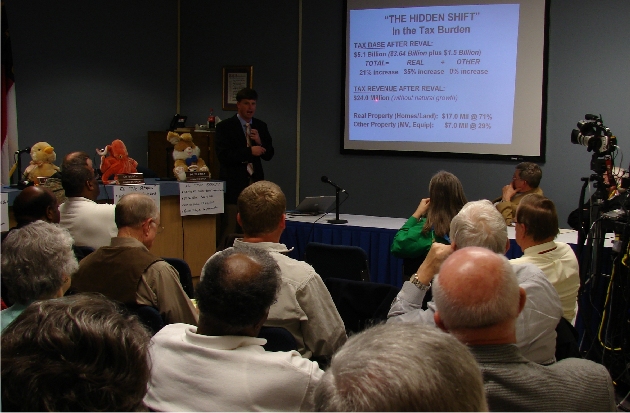This article has been provided to Beaufort County Now, and is posted subsequent to a special called meeting, on December 22, 2009, of the Beaufort County Commission regarding the impending Revaluation.
In February, the County will comply with a state government mandate that will bring increased property taxes for most homeowners and landowners when they receive their tax bill in September, 2010.
North Carolina law requires the County take action every eight years to update the value of all real estate for purposes of taxation. This "revaluation" of real estate will update the value of each home or parcel of land previously established for tax purposes in 2002 to a taxable value intended to represent 2010 market value.
County officials, however, anticipate little increase in property tax revenue due to a significant decrease in the property tax rate to be adopted in June. The County expects to accomplish as closely as possible a property tax rate that is "revenue neutral" as defined by the North Carolina General Statutes (State law). As a result, the County anticipates tax bill decreases for many taxpayers who own vehicles, equipment, boats, and airplanes.
Beaufort County Commissioners held a special televised session on December 22, 2009 to better understand the confusion created by the eight year revaluation of homes and land for tax purposes. (You can view the 1 hour broadcast by tuning in to a local cable access channel or visiting a local library to check out the 12/22/09 County Commissioner DVD.)
The State's law requiring "revaluation" at least every eight years corrects unfairness among the differences in taxable value of individual pieces of property compared to the market value of these same pieces of property. Once complete, revaluation allows every kind of property in the following two general categories to be taxed fairly and uniformly with a single property tax rate to be set by the elected County Commissioners:
CATEGORY 1: "Real Estate or Property Category" (homes, land, buildings) and CATEGORY 2: "Other Property Category" (vehicles, equipment, boats, airplanes, etc.).
In year 1 of the County.s previous eight-year cycle (2002), all property paid 100 percent (plus or minus) of its fair share of the tax burden. At that time all property paid a property tax bill calculated on a taxable value that measured approximately 100% of the market value for a given piece of real estate in the “Real Property Category”. Equally, each non-real estate asset in the County such as vehicles, manufacturing equipment, boats, and airplanes included in the "Other Property Category" also paid a property tax bill calculated on a taxable value that measured approximately 100% of its market value.

County Manager Paul Spruill is pictured here explaining to concerned citizens, and the county commissioners, the consequences of the impending revaluation: Above. And again here below the County Manager explaining the "Hidden Shift of the Tax Burden."

In years 2 to 5 of the County's previous eight year cycle (2003-2006) significant unfairness quickly developed not only between these two categories when compared to each other, but also within the "Real Property Category" itself.
All real estate benefitted from a frozen taxable value applied by the County back in 2002 (year 1 of the previous cycle) while the market value for the same piece of real estate or real property appreciated greatly in 2003-2006 (years 2 to 5). As a result, with every year that passed all owners of real estate or real property paid less and less of their fair share of their true tax burden that was previously accomplished in 2002. In fact, some estimates indicate that on average in 2006 the taxable value of Beaufort County real estate measured as little as 62% of its market value.
Of course, examples existed where individual properties were far different from the average. Some homeowners benefitted from property tax bills based on a value as little as 5% of their fair share when compared to the appreciated market value of their home. Other homeowners suffered a property tax bill on a value as great as 97 percent of the market value for their home due to little or no appreciation from 2002 to 2006 for their property.
Meanwhile, ALL owners of the "Other Property" category (vehicles, manufacturing equipment, boats, airplanes, etc.) unfairly shouldered 100 percent of their true tax burden because each of these assets suffered revaluation for the purpose of taxation in every calendar year of the previous eight year cycle. In other words, each asset included in this "Other Property" group suffered a tax bill calculated on a taxable value that was updated to represent approximately 100 percent of the market value of each asset not only in year 1 of the cycle (2002), but also in years 2, 3, 4, and 5 of the cycle (2003-2006).
In years 6, 7, and 8 of the previous eight year cycle (2006-2009) the market value of real estate slowed or ended its steady climb and, in many cases, declined in value. This change in the real estate market caused the degree of unfairness that developed between the "Real Property Category" and the "Other Property Category" to level off. The unfairness between the two categories and the unfairness among individual homes within the "Real Property Category" has not disappeared, however.
With some exceptions, the taxable value of homes and land (established in 2002) continues to lag the market value for the same property in 2010. In fact, the County Manager has gone so far as to take a guess that on average "revaluation" of homes and land will result in an average increase in taxable value of 35 percent for all real estate from 2002 to 2010. This would result in an increase of 21 percent in the County's overall tax base for both categories.
This outcome, if true, would cause the percentage of total property tax dollars collected by the County from the "Real Property Category" to increase from 64% to 71% of all tax dollars collected.
In other words, the burden of paying the County's total property tax pie would shift from the "Other Property Category" to the "Real Property Category" to such a degree that homes and land would take on the burden of an estimated $1.6 million in property tax payments that previously belonged to the "Other Property Category" (vehicles, manufacturing equipment, boats, airplanes, etc.).
This prediction of a "HIDDEN SHIFT" in the tax burden that will bring tax relief to the "Other Property Category" at the expense of the "Real Property Category" causes the County Manager to estimate on average a 10 to 12 percent increase in property taxes for each separate home or parcel of land.
These predictions assume a great many unknowns, however, including:
(a) An accurate measure of the average increase in taxable value of real estate from 2002 to 2010 (the County Manager has speculated 35%),
(b) An accurate measure of the appeals or adjustments that county taxpayers seek upon receiving in February by mail the new taxable value of property they own (the County Manager has speculated an unrealistic estimate of 0 losses),
(c) That the County will adopt a “revenue neutral” tax rate that excludes natural growth from new construction, new and depreciated equipment, new and depreciated motor vehicles, etc. (the County Manager has repeatedly stated that the "revenue neutral" tax rate will in fact be adjusted to include natural growth as permitted by State law)
No matter the accuracy of the predictions, the County's efforts to comply with the State's mandated revaluation in 2010 will make an already tough economic condition for most County homeowners and landowners even more difficult. For these taxpayers, the County's declaration that it has adopted a "revenue neutral tax rate" and resolved the problem of unfairness will be of zero consolation.












 County Manager Paul Spruill is pictured here explaining to concerned citizens, and the county commissioners, the consequences of the impending revaluation: Above. And again here below the County Manager explaining the "Hidden Shift of the Tax Burden."
County Manager Paul Spruill is pictured here explaining to concerned citizens, and the county commissioners, the consequences of the impending revaluation: Above. And again here below the County Manager explaining the "Hidden Shift of the Tax Burden."










